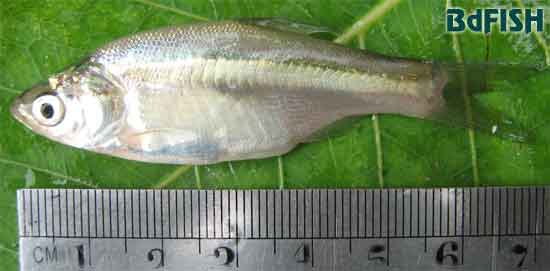
Systematic position:
Phylum: Chordata
Class: Actinopterygii (Ray-finned fishes)
Order: Cypriniformes (Carps)
Family: Cyprinidae (Carps and minnows)
Genus: Amblypharyngodon
Species: A. mola
Synonyms: Amblypharyngodon pellucidus (McClelland, 1839), Leuciscus pellucidus (McClelland, 1839), Cyprinus mola (Hamilton, 1822), Leuciscus mola (Hamilton, 1822), Mola buchanani (Blyth, 1860), Amblypharyngodon saranensis (Chaudhuri, 1912).
Common/Local names: Mola, Moa, Moshi (Bangladesh); Mola carplet and Pale carplet (English); Mola carplet (Fishbase).
Distribution: Bangladesh, India, Myanmar and Pakistan (Talwar and Jhingran, 1991).
Conservation status: Non threatened in Bangladesh
Morphology: Body laterally compressed and dorsal profile is more convex than that of ventral. No barbels. Caudal fin deeply forked and lobes are pointed. Dark markings present in dorsal and anal fins. Body color light greenish on back and silvery at sides and beneath.
Maximum length reported 8 cm (Bhuiyan, 1964), 20 cm (Talwar and Jhingran, 1991), 9.2 cm (Hussain, 1999), and 9 cm (Rahman, 1989). Highest length measured 6.5 cm in 2007 in the Chalan Beel of Bangladesh.
Head 27.1% SL and 21.9% TL. Height 27.1% SL and 21.9% TL. Eye 31.3% HL. Lateral line present and complete with about 60-75 scales. A conspicuous silvery lateral band running from gill covers to base of caudal fin.
Fin formula: D. 9 (2/7); P1. 15; P2. 9; A. 7 (2/5) (Rahman, 1989)
Habitat: Available in the rivers, streams, beels and tanks and gets an invigorating effect in growth on change from one pond to the other (Bhuiyan, 1964). According to Rahman (1989), extensive found in rivers, canals, beels, ponds and inundated fields of Bangladesh. Recorded in Chalan Beel (Galib et al., 2009) and Bookbhara Baor (Mohsin et al., 2009) of Bangladesh
Food and feeding: Surface feeder and feed on unicellular algae, protozoa, rotifera and crustaceans (Bhuiyan, 1964).
Breeding: Between May and October (Bhuiyan, 1964; Rahman, 1989). Fecundity is about 500 and translucent, spherical, demersal, adhesive without oil gobules, with a granular egg-membrane and 0.6 mm in diameter (Bhuiyan, 1964). Egg laying tendency increases at the commencement of the rains (Bhuiyan, 1964).
Economics importance: Used as food fish in Bangladesh.
Marketing: Marketed in fresh or dried condition (Samad et al., 2009).
_____________________________________________________________
References
Bhuiyan AL. 1964. Fishes of Dacca, Asiat. Soc. Pakistan, Pub. 1, No. 13, Dacca, pp. 39-40.
Blyth E. 1860. Report on some fishes received chiefly from the Sitang River and its tributary streams, Tenasserim Provinces., J. Asiatic Soc. Bengal, pp. 138-174.
Chaudhuri BL. 1912. XXXV. Descriptions of some new species of freshwater fishes from north India. Rec. Indian Mus. (Calcutta), pp. 437-444.
Day F. 1878. Fishes of India: being a Natural History of the Fishes Known to Inhabit the Sea and Freshwater of India, Ceylon and Burma, Atlas in 4th part, London, 778 p.
Galib SM, Samad MA, Mohsin ABM, Flowra FA and Alam MT. 2009. Present Status of Fishes in the Chalan Beel- the Largest Beel (Wetland) of Bangladesh, Int. J. Ani. Fish. Sci. 2(3): 214-218.
Hamilton F (Buchanan). 1822. An account of the fishes found in the river Ganges and its branches, Edinburgh & London, Fishes Ganges, pp. 1-405.
Hussain MM. 1999. Fishes and Fisheries of the River Atrai in Rajshahi with Reference to its Limnology, unpublished Ph.D. thesis, Department of Zoology, University of Rajshahi, Bangladesh, pp. 5-200.
Jerdon TC. 1849. On the fresh-water fishes of southern India. (Continued from p. 149.), Madras J. Lit. Sci., pp. 302-346.
McClelland J. 1839. Indian Cyprinidae, Asiatic Researches, pp. 217-471.
Mohsin ABM, Hasan MM and Galib SM. 2009. Fish Diversity of Community Based Fisheries Managed Oxbow Lake (Bookbhara Baor) in Jessore, Bangladesh, J. Sci. Foundation 7(1): 121-125.
Mookerjee HK, Sen Gupta SN and Roy Choudhury DN. 1946. Food and its percentage composition of the common adult food fishes of Bengal, Sci. & Cult. Calcutta, 12(7):247.
Rahman AKA. 1989. Freshwater Fishes of Bangladesh, 1st edition, Zoological Society of Bangladesh, Department of Zoology, University of Dhaka, Dhaka-1000, pp. 105-106.
Samad MA, Galib SM and Flowra FA. Fish Drying in Chalan Beel Areas, Bangladesh J. Sci. Ind. Res. 44(4): 461-466.
Talwar PK and Jhingran AG. 1991. Inland Fishes of India and Adjacent Countries, Vol. I, Oxford & IBH Publishing Co. Pvt. Ltd. New Delhi-Calcutta, p. 338.
Visited 11,064 times, 3 visits today | Have any fisheries relevant question?
